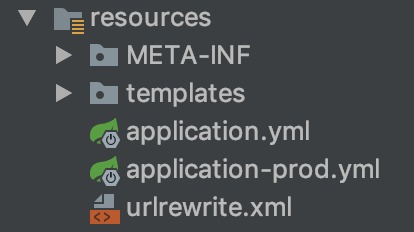关于 urlrewrite
urlrewrite 使用强大的自定义规则来使用用户更容易记住、搜索引擎更容易找到的 URL(对于 seo 比较重要)。通过使用规则模板、重写映射,Web 管理员可以轻松地设置规则,根据 HTTP 标头、HTTP 响应或请求标头、变量,甚至复杂的编程规则来定义 URL 重写行为。此外,Web 管理员可以根据重写规则中表示的逻辑进行 url 重定向、发送自定义响应或停止 HTTP 请求。
为何有这篇教程?
百度上查询 urlrewrite 这个工具包的使用教程时,网上并没有 springboot 整合的完整示例,于是就自己摸索的写了一下。
开始:
1. 引入 maven 依赖:
<dependency>
<groupId>org.tuckey</groupId>
<artifactId>urlrewritefilter</artifactId>
<version>4.0.4</version>
</dependency>
2. 重写 UrlRewriteFilter 的过滤器加载 urlrewrite.xml 规则,urlrewrite.xml 放在 resources 文件夹下

package webapp.conf;
import org.springframework.beans.factory.annotation.Value;
import org.springframework.context.annotation.Configuration;
import org.springframework.core.io.Resource;
import org.tuckey.web.filters.urlrewrite.Conf;
import org.tuckey.web.filters.urlrewrite.UrlRewriteFilter;
import javax.servlet.FilterConfig;
import javax.servlet.ServletException;
import java.io.IOException;
@Configuration
public class UrlRewriteConf extends UrlRewriteFilter {
private static final String URL_REWRITE = "classpath:/urlrewrite.xml";
//注入urlrewrite配置文件
@Value(URL_REWRITE)
private Resource resource;
//重写配置文件加载方式
protected void loadUrlRewriter(FilterConfig filterConfig) throws ServletException {
try {
//将Resource对象转换成Conf对象
Conf conf = new Conf(filterConfig.getServletContext(), resource.getInputStream(), resource.getFilename(), "@@traceability@@");
checkConf(conf);
} catch (IOException ex) {
throw new ServletException("Unable to load URL rewrite configuration file from " + URL_REWRITE, ex);
}
}
}
3.urlrewrite.xml 文件配置,urlrewrite.xml 规则示例:
<?xml version="1.0" encoding="utf-8"?>
<!DOCTYPE urlrewrite PUBLIC "-//tuckey.org//DTD UrlRewrite 3.2//EN"
"http://tuckey.org/res/dtds/urlrewrite3.2.dtd">
<urlrewrite>
<rule>
<name>seo redirect 301</name>
<condition >^9191boke.com$</condition>
<from>^/(.*)</from>
<to type="permanent-redirect" last="true">http://www.9191boke.com/$1</to>
</rule>
<rule>
<name>seo redirect 301</name>
<condition >^localhost:9191$</condition>
<from>^/(.*)</from>
<to type="permanent-redirect" last="true">http://www.localhost:9191/$1</to>
</rule>
<rule>
<from>^/([0-9]+).html$</from>
<to>/blogdetails/$1.html</to>
</rule>
<rule>
<from>^/p_([0-9]+).html$</from>
<to>/?page=$1</to>
</rule>
</urlrewrite>
from 标签内的表示匹配的模式,标签内的是想要转换的模式。
<rule>
<name>seo redirect 301</name>
<condition >^9191boke.com$</condition>
<from>^/(.*)</from>
<to type="permanent-redirect" last="true">http://www.9191boke.com/$1</to>
</rule>
以上为域名 301 重定向,所有 http(s)://9191boke.com/xxx 链接会重定向至 http://www.9191boke.com/xxx
<from>^/([0-9]+).html$</from>
<to>/blogdetails/$1.html</to>
^/([0-9]+).html$ 表示 http://xxx / 数字. html 会发送实际请求为 http://xxx/blogdetails / 数字. html
<rule>
<from>^/p_([0-9]+).html$</from>
<to>/?page=$1</to>
</rule>
^/p_([0-9]+).html$ 表示 http://xxx/p_数字. html 会发送实际请求为 http://xxx/?page = 数字. html
每一条拦截规则使用 rule 标签包裹。
这里没有特别需要注意的地方,如果只是简单的使用的话, 记住下面这一点就足够了。
如果你会用正则表达式的话,可以通过正则表达式来处理 (推荐使用),如果不会,可以使用通配符。
作者:007少侠
来源链接:
https://www.cnblogs.com/007sx/p/11758832.html
